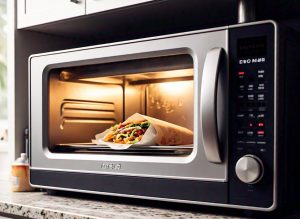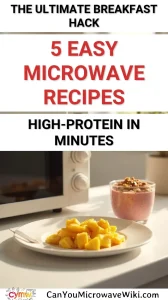Salmonella is a genus of bacteria that causes foodborne illness, often linked to contaminated poultry, meat and dairy products.
The question at hand is whether or not a microwave can kill Salmonella.
This article examines the effectiveness of microwaving in killing Salmonella. It includes key details about this bacterium, facts on its heat resistance, and how much microwave exposure it needs for complete eradication without diminishing the quality of your food. If microwaving can’t fully eradicate Salmonella, we’ll discuss alternative methods for safe cooking along with valuable tips and precautions to prevent infection. We will also feature frequently asked questions pertaining to this topic and provide our final thoughts on using a microwave as a method for eliminating Salmonella.

Jump To:
Does a Microwave Kill Salmonella?
A microwave can indeed kill Salmonella bacteria, but only when used correctly. The critical factor is heating the food to an internal temperature of at least 165°F (74°C) for a sufficient duration, which effectively eliminates any Salmonella present. However, microwaves often heat unevenly, leading to “cold spots” where bacteria like Salmonella might survive. Therefore, it’s safer to use conventional cooking methods for foods likely to carry these pathogens.
Check out if microwave can kill bacteria.
Facts About Salmonella
Here, we will discuss the important things to note about Salmonella.
- Type of Bacteria: Salmonella is a genus of rod-shaped bacteria and is one of the most common causes of foodborne illness.
- Infection: The infection caused by this bacterium is called salmonellosis which presents symptoms like fever, diarrhea, and abdominal cramps.
- Sources: Common sources include raw or undercooked meat, poultry, eggs and egg products.
- Growth Temperature: It thrives in temperatures between 7°C (45°F) and 37°C (99°F), but can survive outside this range too.
- Killing Temperature: Most Salmonella species are killed by heating to a temperature of at least 70°C (158°F) for ten minutes or more.
We have discussed some vital facts about Salmonella. Now let’s discuss how microwaving affects it.
Check out if ants can survive a microwave.
How Long Can You Microwave to Kill Salmonella?
The duration required to microwave food that might contain Salmonella varies based on its type and quantity. Generally, heating food at high temperatures for about 60 seconds is sufficient to kill most bacteria, including Salmonella. A meat thermometer is an effective tool for ensuring it reaches 165 degrees Fahrenheit (73.9 degrees Celsius), which is also the USDA recommended temperature.
Does Heating Food Potentially Containing Salmonella in a Microwave Destroy its Nutrients?
Microwaving does not inherently destroy more nutrients in food than conventional cooking methods. The loss of nutrients during cooking is related more to the heat exposure duration and amount of liquid used rather than the cooking method itself. Therefore, while microwaving potentially salmonella-infected foods kills bacteria, it generally preserves most of their vital nutrients as well.
Check out if microwave radiation hurt you.
Does Heating Food in a Microwave Affect its Flavors?
Microwave reheating or cooking could alter the flavor of some foods but this effect isn’t exclusive to microwaves; any form of heat can cause taste changes due to chemical reactions within the ingredients themselves. However, since microwaves cook faster and use less water compared with traditional methods, they may actually preserve flavors better by minimizing nutrient leakage into water or overcooking.
In conclusion, while there are concerns regarding flavor alterations when reheating or cooking via microwaves and potential nutrient loss from overheating – overall these are negligible when compared with other conventional ovens.
We will now discuss FAQs in our next section regarding this topic above.

Frequently Asked Questions (FAQs)
In this section, we will now look at the most commonly asked questions related to microwaving and heating.
Can a microwave kill Salmonella?
Yes, a microwave can kill Salmonella. When you heat food in a microwave, it heats the food evenly and rapidly due to its high-frequency electromagnetic waves. This process raises the temperature of the food high enough, above 165°F or 74°C which is required to kill bacteria including salmonella. However, uneven heating could leave some areas with living bacteria so it’s imperative for your safety that you ensure thorough cooking.
Does microwaving food destroy nutrients?
Microwaving does not generally destroy nutrients in food any more than traditional cooking methods do. Just like other cooking techniques such as roasting or boiling, some nutrient loss can occur but it’s usually minimal because microwaves cook foods quickly thus reducing nutrient degradation caused by prolonged exposure to heat.
Can microwaving plastic be harmful?
Microwaving plastic containers can potentially be harmful if the plastic isn’t marked as “microwave safe“. In unsafe plastics, microwaves may cause chemicals like BPA and phthalates to leach into your food which are linked with potential health risks. Always look for containers labeled ‘Microwave Safe’ before heating them up in a microwave oven.
Are microwaved foods unhealthy?
No evidence suggests that consuming foods heated via microwave makes them unhealthy per se. Although some concerns have been raised about radiation leakage from old or damaged units leading to harmful exposure over time; modern units are designed to minimize this risk though proper maintenance and usage are still necessary for utmost safety.
We hope these answers helped to clear up some of the common queries related to microwaving and heating.
Final Words
Microwaves are a useful tool, offering convenience and speed in our modern fast-paced lifestyle. They are generally safe and efficient for both reheating leftovers or cooking meals from scratch. While they can kill harmful bacteria like Salmonella when used properly, one should still take precautions such as using microwave-safe containers to avoid potential health risks associated with leaching chemicals into your food or uneven heating leading to potentially hazardous bacterial growth.



